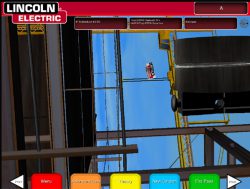Using the VRTEX For Out of Position Welds
by Chris Gandee
The Set up:
Overview:
The VRTEX® 360 can be used to teach the user proper set up and position of a work piece for different types of joints and welds. The system also teaches beginning welders how to manipulate the user’s body or stance to create the best, basic weld; and advanced welders on body placement for more difficult and awkward positions typically found in the field.
Available Positions andCoupons :

 Flat plate:only in the flat position
Flat plate:only in the flat position
The tee joint:
2F – horizontal fillet weld
3F – vertical fillet weld
4F – overhead fillet weld
 The groove joint: 1G – flat groove weld
The groove joint: 1G – flat groove weld
3G – vertical groove weld
4G – overhead groove weld

 2G – horizontal pipe weld
2G – horizontal pipe weld
5G – vertical pipe weld
NOTE:The only time the “Pipe Pin” should be removed is during the set up for the 5G and 6G pipe welds.
The work table, designed to mimic an actual welding table, can be adjusted to different work positions to simulate a number of scenarios such as a basic flat plate weld too hard to reach welds such as low pipe lines.




For example: if the machine is set-up for a 5G 6” Diameter Schedule 40 Weld and the pipe pin to bend the arm to 90º is not used, the actual model in the virtual environment will appear sideways, as shown below.
The VRTEX® 360 has a number of program methods and manipulations. For more information, see theOperators Manualpages B-9 to B-11. Remember, the system is only limited by your imagination.


